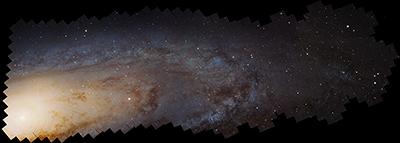
A Hubble image of a portion of the Andromeda Galaxy, a nearby spiral that generally resembles the Milky Way. Astronomers have proposed a new method to measure the total mass of the Milky Way using hypervelocity stars.
The physical properties of the Milky Way, our home galaxy, and its evolutionary history are keys to understanding the history of galaxy formation across the cosmos, and details like the efficiency of converting atoms into stars, the development of satellite galaxies like the Magellanic Clouds, and more. One parameter, the total mass of the Milky Way, is particularly relevant but still quite uncertain. It is difficult to measure not only because we lie deep in the innards of the galaxy itself, but also because most of the mass is in the form of dark matter that does not radiate. Current estimates of the galaxy’s total mass are based on the motions of tidal streamers of gas and globular clusters, both influenced by the gravitational mass of the galaxy, and range from one to several trillion solar-masses.
CfA astronomer Avi Loeb and his colleague have come up with a novel and effective way of estimating the Milky Way’s total mass: modeling the motions of hypervelocity stars, stars that are thought to be ejected from the galaxy as a result of interactions of binary stars with the supermassive black hole at our galaxy’s center. More than twenty of these stars have been found so far, moving at velocities of up to 700 kilometers/second and located at distances more than one hundred and fifty thousand light-years from the galactic center. While the exact mechanism for producing these stars is still debated, their orbits are completely determined by the gravitational field of the galaxy, which can be deduced.
The astronomers adopt a nominal travel time for these observed hypervelocity stars of three hundred and thirty million years, which corresponds to their average lifetime burning hydrogen fuel. Combined with other kinematic information about these stars, the scientists calculate that the mass of the galaxy is between 1.2 and 1.9 trillion solar masses, adding significant precision to the previous estimates.
"Constraining Milky Way Mass with Hypervelocity Stars," G. Fragione and A. Loeb, A&A, in press (2017).
Related News
CfA Scientists Play Important Role in New NASA Mission
Runaway Stars Reveal Hidden Black Hole In Milky Way’s Nearest Neighbor
CfA Celebrates 25 Years with the Chandra X-ray Observatory
CfA Astronomers Help Find Most Distant Galaxy Using James Webb Space Telescope
Unexpectedly Massive Black Holes Dominate Small Galaxies in the Distant Universe
Distant Stars Spotted for the First Time in the Vast Magellanic Stream
CfA Scientists Help Reach New Milestone in Quest for Distant Galaxies
Astrophysicists Hunt for Second-Closest Supermassive Black Hole
The Tilt in our Stars: The Shape of the Milky Way's Halo of Stars is Realized
JWST Draws Back Curtain on Universe's Early Galaxies
Projects
2MASS Redshift Survey
AstroAI
Dark Energy Spectroscopic Instrument (DESI)
GMACS
For Scientists